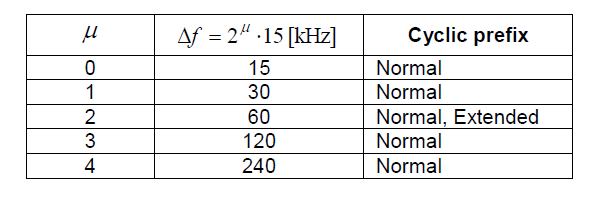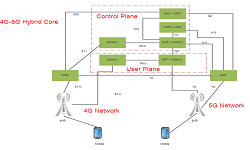Motivation Behind Having Multiple Numerology in 5G NR
Talking about numerology, as we know LTE has single subcarrier spacing equal to 15khz, but here in NR, we have multiple numerologies and those are represented by Greek letter µ. So 15khz will be the smallest subcarrier spacing and shown in the table we have wider subcarrier spacing.

NR has subcarrier spacing ranging from 15 to 240 KHz, and extended Cyclic Prefix(CP) is also supported in 60khz subcarrier spacing. So LTE has only single possible value of subcarrier spacing while NR has multiple values. Idea of numerology is to have representation of various subcarrier spacing.
Now let’s understand the motivation behind having multiple numerology (subcarrier spacing) in NR,
- To support wide range of deployment scenarios ranging from sub 1 Ghz to mm wave applications
- Wider subcarrier spacing are more suitable for deployments with smaller Cell-Size
- Smaller cell size has low delay spread which means we can use lower length CP to reduce overhead on system, therefore CP length (overhead) reduces with cell size as CP is a part of symbol itself and as symbol length and subcarrier spacing are inversely proportional
- Wider subcarrier spacing makes system robust to phase noise
- Phase noise increase with LO frequency but decrease with subcarrier spacing therefore if we want to operate in higher frequency ranges, we should use wider subcarrier spacing to mitigate phase noise
- Wider subcarrier spacing are also suitable to support low latency services
- In NR scheduling happens on slot level, therefore latency of system is determined by slot duration, so lower slot duration or wider subcarrier spacing implies low latency
- Narrow subcarrier spacing should be used in delay spread intensive environments
- As explained above but in cases where delay spread is high CP length should also be higher, in those cases we should be using narrow subcarrier spacing like 15 or 30khz,
- Now you might be thinking that in these cases we will not have wider subcarrier spacing advantages, but for this 3GPP allowed to have extended CP in 60khz case as we earlier saw in numerology table
- Inter numerology interference, as there is a famous saying nothing come for free, till now we had discussed all the advantages of multiple subcarrier spacing, but one minus point is multiple numerology create inter numerology interference, there are some techniques to mitigate or reduce this
- To reduce inter-numerology interference
- Spectral confinement is important to reduce inter-numerology interference as well as out-of-band (OOB) emissions

-
- Spectral roll-off for an OFDM waveform becomes steeper as subcarrier spacing decreases.
- In the below picture, PSDs of two equal bandwidth OFDM signals with subcarrier spacing of 15 kHz and 480 kHz have been compared, it can be observed that spectral roll-off of 15KHz waveform (shown in red colour) is more steeper than 480KHz waveform.
Related Posts and detailed explanation is available in following Video:
- https://www.youtube.com/watch?v=RagHojSWEz8&t
- 5G Subcarrier Spacing, Frame and Subframe, Slot and OFDM Symbol
- 5G NR Resource Block Definition and RB calculations



